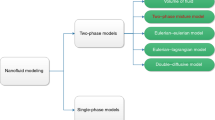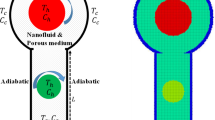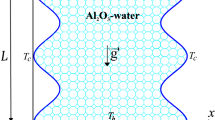Abstract
This work deals with natural convection flow resulting from rotating circular cylinders in a horizontal wavy cavity fully filled by nanofluid. The horizontal wavy cavity was saturated by three layers of heterogeneous porous media. Incompressible smoothed particle hydrodynamics (ISPH) method is used to solve the non-dimensional governing equations of the current physical problem. Three circular cylinders are carrying a hot temperature with a uniform circular velocity inside a horizontal wavy cavity. Effects of physical parameters including circular cylinder radius \((0.05\le R_{\text {c}}\le 0.3)\), Darcy parameter \(({10}^{-3}\le {\text {Da}}\le {10}^{-5})\), Rayleigh number \(({10}^{3}\le {\text {Ra}}\le {10}^{5})\), nanoparticles volume fraction \((0\le \phi \le 6\% )\), and paddle lengths \((0.05\le L_{\text {paddl}}\le 0.2)\) on fluid flow and heat transfer were examined. Results revealed that an increase on radius of inner cylinders rises temperature distributions and nanofluid flow. A decrease on Darcy parameter weakens fluid flow. A growth on paddle lengths enhances velocity field in all the porous layers. In the current simulations, ISPH method showed a well performance in simulating natural convection flow of nanofluid inside a novel geometry (horizontal wavy cavity).













Similar content being viewed by others
References
A.K. Kareem, S. Gao, A comparison study of mixed convection heat transfer of turbulent nanofluid flow in a three-dimensional lid-driven enclosure with a clockwise versus an anticlockwise rotating cylinder. Int. Commun. Heat Mass Transfer 90, 44–55 (2018)
A.K. Kareem, S. Gao, Mixed convection heat transfer of turbulent flow in a three-dimensional lid-driven cavity with a rotating cylinder. Int. J. Heat Mass Transf. 112, 185–200 (2017)
T. Wang, Z. Huang, G. Xi, Entropy generation for mixed convection in a square cavity containing a rotating circular cylinder using a local radial basis function method. Int. J. Heat Mass Transf. 106, 1063–1073 (2017)
K. Khanafer, S. Aithal, Mixed convection heat transfer in a lid-driven cavity with a rotating circular cylinder. Int. Commun. Heat Mass Transfer 86, 131–142 (2017)
F. Selimefendigil, H.F. Öztop, Mixed convection of nanofluids in a three dimensional cavity with two adiabatic inner rotating cylinders. Int. J. Heat Mass Transf. 117, 331–343 (2018)
Y.M. Seo, M.Y. Ha, Y.G. Park, A numerical study on the three-dimensional natural convection with a cylinder in a long rectangular enclosure. Part I: Size effect of a circular cylinder or an elliptical cylinder, International Journal of Heat and Mass Transfer 134, 420–436 (2019)
Y.M. Seo, M.Y. Ha, Y.G. Park, A numerical study on the three-dimensional natural convection with a cylinder in a long rectangular enclosure. Part II: Inclination angle effect of the elliptical cylinder, International Journal of Heat and Mass Transfer 131, 795–806 (2019)
R. Hassanzadeh, R. Rahimi, A. Khosravipour, S. Mostafavi, H. Pekel, Analysis of natural convection in a square cavity in the presence of a rotating cylinder with a specific number of roughness components. International Communications in Heat and Mass Transfer 116 (2020)
R. Nasrin, Influences of Physical Parameters on Mixed Convection in a Horizontal Lid-Driven Cavity with an Undulating Base Surface. Numerical Heat Transfer, Part A: Applications 61(4), 306–321 (2012)
A.I. Alsabery, M.A. Ismael, A.J. Chamkha, I. Hashim, Numerical investigation of mixed convection and entropy generation in a wavy-walled cavity filled with nanofluid and involving a rotating cylinder. Entropy 20(9), 664 (2018)
A.I. Alsabery, R. Mohebbi, A.J. Chamkha, I. Hashim, Effect of local thermal non-equilibrium model on natural convection in a nanofluid-filled wavy-walled porous cavity containing inner solid cylinder. Chem. Eng. Sci. 201, 247–263 (2019)
M. Sheikholeslami, Finite element method for PCM solidification in existence of CuO nanoparticles. J. Mol. Liq. 265, 347–355 (2018)
M. Sheikholeslami, Numerical approach for MHD Al2O3-water nanofluid transportation inside a permeable medium using innovative computer method. Comput. Methods Appl. Mech. Eng. 344, 306–318 (2019)
Y.M. Seo, K. Luo, M.Y. Ha, Y.G. Park, Direct numerical simulation and artificial neural network modeling of heat transfer characteristics on natural convection with a sinusoidal cylinder in a long rectangular enclosure. International Journal of Heat and Mass Transfer 152 (2020)
H.T. Kadhim, F.A. Jabbar, A. Rona, Cu-Al2O3 hybrid nanofluid natural convection in an inclined enclosure with wavy walls partially layered by porous medium. International Journal of Mechanical Sciences 186 (2020)
R.W. Lewis, P. Nithiarasu, K.N. Seetharamu, Fundamentals of the finite element method for heat and fluid flow (John Wiley & Sons, 2004)
R.W. Lewis, B.A. Shrefler, The finite element method in the static and dynamic deformation and consolidation of porous media (Wiley, Chichester, England, 1998)
P. Nithiarasu, R.W. Lewis, K.N. Seetharamu, Fundamentals of the finite element method for heat and mass transfer (John Wiley & Sons, 2016)
R.A. Gingold, J.J. Monaghan, Smoothed particle hydrodynamics: theory and application to non-spherical stars. Mon. Not. R. Astron. Soc. 181(3), 375–389 (1977)
S.J. Cummins, M. Rudman, An SPH Projection Method. J. Comput. Phys. 152(2), 584–607 (1999)
R. Xu, P. Stansby, D. Laurence, Accuracy and stability in incompressible SPH (ISPH) based on the projection method and a new approach. J. Comput. Phys. 228(9), 6703–6725 (2009)
M. Asai, A.M. Aly, Y. Sonoda, Y. Sakai, A stabilized incompressible SPH method by relaxing the density invariance condition. Journal of Applied Mathematics 2012 (2012)
A. Khayyer, H. Gotoh, H. Falahaty, Y. Shimizu, An enhanced ISPH-SPH coupled method for simulation of incompressible fluid-elastic structure interactions. Comput. Phys. Commun. 232, 139–164 (2018)
R.A. Dalrymple, B. Rogers, Numerical modeling of water waves with the SPH method. Coast. Eng. 53(2–3), 141–147 (2006)
M. Ferrand, D.R. Laurence, B.D. Rogers, D. Violeau, C. Kassiotis, Unified semi-analytical wall boundary conditions for inviscid, laminar or turbulent flows in the meshless SPH method. Int. J. Numer. Meth. Fluids 71(4), 446–472 (2013)
A.M. Aly, M. Asai, Y. Sonda, Modelling of surface tension force for free surface flows in ISPH method. International Journal of Numerical Methods for Heat & Fluid Flow 23(3), 479–498 (2013)
X. Liu, P. Lin, S. Shao, An ISPH simulation of coupled structure interaction with free surface flows. J. Fluids Struct. 48, 46–61 (2014)
A.M. Aly, M. Asai, Water entry of decelerating spheres simulations using improved ISPH method. Journal of Hydrodynamics 30(6), 1120–1133 (2018)
A.M. Aly, M. Asai, Y. Sonoda, Simulation of free falling rigid body into water by a stabilized incompressible SPH method. Ocean Sys. Eng. 1(3), 207–222 (2011)
M. Danis, M. Orhan, A. Ecder, ISPH modelling of transient natural convection. International Journal of Computational Fluid Dynamics 27(1), 15–31 (2013)
A.M. Aly, M. Asai, Double-Diffusive Natural Convection with Cross-Diffusion Effects in an Anisotropic Porous Enclosure Using ISPH Method (Advancement in Process Modelling, Mass Transfer, 2015), p. 65
A.M. Aly, A. Chamkha, S.-W. Lee, A. Al-Mudhaf, On Mixed Convection in an Inclined Lid-Driven Cavity with Sinusoidal Heated Walls using ISPH Method, Computational Thermal Sciences: An International Journal, (2016)
A.M. Aly, Double-diffusive natural convection in an enclosure including/excluding sloshing rod using a stabilized ISPH method. International Communications in Heat and Mass Transfer 73 (2016)
M.T. Nguyen, A.M. Aly, S.-W. Lee, Effect of a wavy interface on the natural convection of a nanofluid in a cavity with a partially layered porous medium using the ISPH method. Numerical Heat Transfer, Part A: Applications 72(1), 68–88 (2017)
A.M. Aly, Z. Raizah, Incompressible smoothed particle hydrodynamics (ISPH) method for natural convection in a nanofluid-filled cavity including rotating solid structures. Int. J. Mech. Sci. 146, 125–140 (2018)
A.M. Aly, S.E. Ahmed, ISPH simulations for a variable magneto-convective flow of a ferrofluid in a closed space includes open circular pipes. International Communications in Heat and Mass Transfer 110 (2020)
A.M. Aly, Z.A.S. Raizah, Incompressible smoothed particle hydrodynamics simulation of natural convection in a nanofluid-filled complex wavy porous cavity with inner solid particles. Physica A: Statistical Mechanics and its Applications 537 (2020)
M.T. Nguyen, A.M. Aly, S.-W. Lee, ISPH modeling of natural convection heat transfer with an analytical kernel renormalization factor. Meccanica 53(9), 2299–2318 (2018)
Y.J. Zhuang, Q.Y. Zhu, Numerical study on combined buoyancy-Marangoni convection heat and mass transfer of power-law nanofluids in a cubic cavity filled with a heterogeneous porous medium. Int. J. Heat Fluid Flow 71, 39–54 (2018)
Z.A.S. Raizah, S.E. Ahmed, A.M. Aly, ISPH simulations of natural convection flow in E-enclosure filled with a nanofluid including homogeneous/heterogeneous porous media and solid particles. International Journal of Heat and Mass Transfer 160 (2020)
M. Corcione, Empirical correlating equations for predicting the effective thermal conductivity and dynamic viscosity of nanofluids. Energy Convers. Manage. 52(1), 789–793 (2011)
F. Garoosi, G. Bagheri, F. Talebi, Numerical simulation of natural convection of nanofluids in a square cavity with several pairs of heaters and coolers (HACs) inside. Int. J. Heat Mass Transf. 67, 362–376 (2013)
V. Bianco, O. Manca, S. Nardini, Entropy generation analysis of turbulent convection flow of Al2O3-water nanofluid in a circular tube subjected to constant wall heat flux. Energy Convers. Manage. 77, 306–314 (2014)
C.-C. Cho, C.-L. Chen, Natural convection heat transfer performance in complex-wavy-wall enclosed cavity filled with nanofluid. Int. J. Therm. Sci. 60, 255–263 (2012)
J. Bonet, S. Kulasegaram, Correction and stabilization of smooth particle hydrodynamics methods with applications in metal forming simulations. Int. J. Numer. Meth. Eng. 47(6), 1189–1214 (2000)
S. Kulasegaram, J. Bonet, R. Lewis, M. Profit, High pressure die casting simulation using a Lagrangian particle method. Commun. Numer. Methods Eng. 19(9), 679–687 (2003)
Acknowledgements
The authors extend their appreciation to the Deanship of Scientific Research at King Khalid University, Abha, Saudi Arabia, for funding this work through the Research Group Project under Grant Number (RGP.1/19/42).
Author information
Authors and Affiliations
Contributions
AMA: performed the programming of in-house code of ISPH method, analysis, and methodology. ZASR: performed writing, and review and editing. SEA: performed the investigation and writing—original draft.
Corresponding author
Rights and permissions
About this article
Cite this article
Aly, A.M., Raizah, Z.A.S. & Ahmed, S.E. ISPH simulations of natural convection from rotating circular cylinders inside a horizontal wavy cavity filled with a nanofluid and saturated by a heterogeneous porous medium. Eur. Phys. J. Spec. Top. 230, 1173–1183 (2021). https://doi.org/10.1140/epjs/s11734-021-00050-y
Received:
Accepted:
Published:
Issue Date:
DOI: https://doi.org/10.1140/epjs/s11734-021-00050-y




